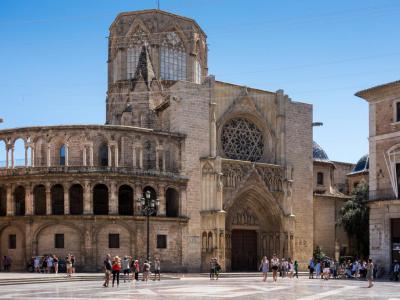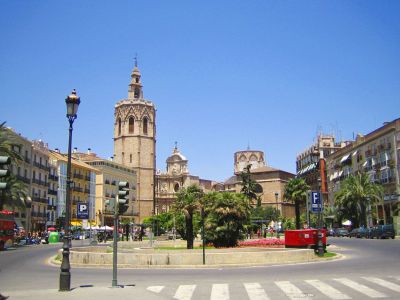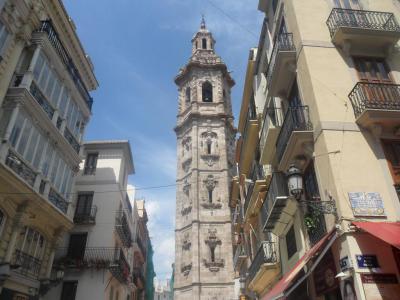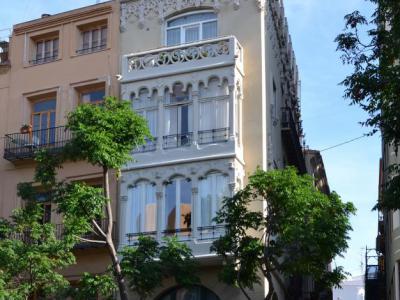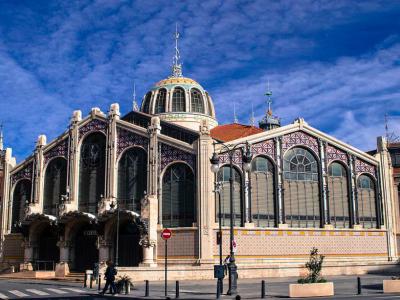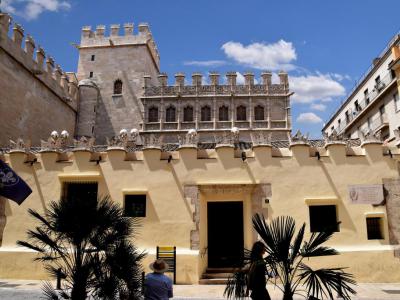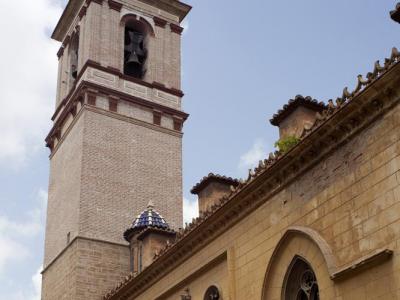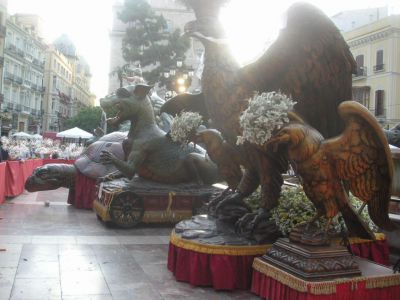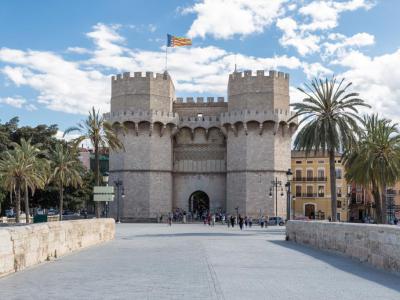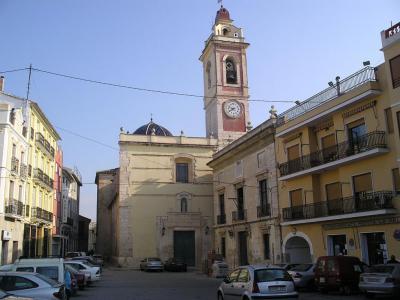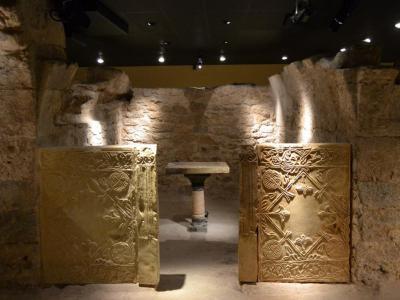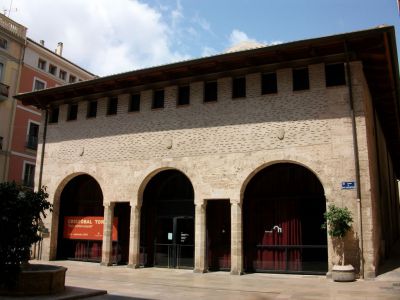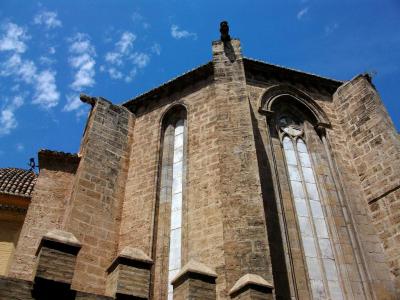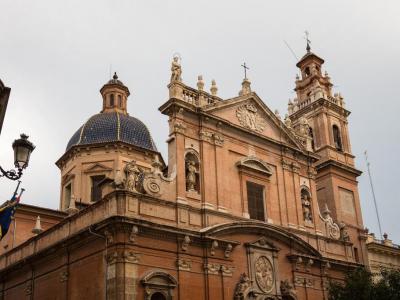Old Town Walking Tour (Self Guided), Valencia
Valencia’s Old Town stands apart from many in Europe for how effortlessly its many layers of history coexist. Beneath modern squares, ancient Roman streets and forum remains lie quietly preserved. The maze-like layout-shaped during the city’s Islamic period-was never swept away after the Christian Reconquest. Instead, it survived and evolved, now lined with Gothic churches and Baroque façades that rise out of a medieval plan still very much in use.
What stands out most is the balance. Civic pride and religious devotion share the spotlight. The Silk Exchange, with its intricate late Gothic design, holds as much weight in the city's story as the Cathedral itself. Baroque elements weren’t forced onto the past-they were layered with intention, giving centuries-old churches a theatrical energy without losing sight of their roots. And through all these changes, the neighborhood has stayed lived-in. People still buy their groceries at the Central Market, children still play near ancient walls. This isn’t a frozen-in-time relic-it’s a place that continues to breathe.
The district flourished after the 14th century, and the Serranos Towers offer one of the clearest windows into that era. Climb to the top, and you’ll get a sweeping view of the city stretching all the way to the sea.
Among the essential stops is, of course, the Cathedral, home to centuries of sacred art and a chalice that many believe to be the Holy Grail. A short walk away, Saint Catherine’s Church stands with a bell tower that’s become a familiar figure on the skyline. Then there’s San Nicolás, where the ceiling bursts with color in a series of frescoes that have earned it comparisons to the Sistine Chapel.
For a glimpse into the city’s earliest Christian chapter, San Juan del Hospital offers a unique perspective. Built by the Knights Hospitaller shortly after the reconquest, the church grounds still contain medieval tombs and remnants of Roman structures tucked just behind the chapel. The parish of Saint Thomas and Saint Philip Neri, meanwhile, brings Baroque style to the fore-with curving lines and classical structure drawn from Roman models, but reshaped in a way that’s unmistakably Valencian.
For something unexpected, the Rocas House-Museum offers a look at Valencia’s festive side-massive floats from the Corpus Christi parades, full of myth and local tradition. And beneath it all, quite literally, the Crypt of San Vicente holds traces of Roman, Visigothic, and Islamic life, layered one on top of another.
Though the area is compact enough to explore on foot, its maze of narrow streets can easily lead you off track. But wandering here is half the joy. To make the most of your visit, take along this self-guided walking tour-move at your own pace, stay curious, and enjoy the layers of history and life unfolding at every turn.
What stands out most is the balance. Civic pride and religious devotion share the spotlight. The Silk Exchange, with its intricate late Gothic design, holds as much weight in the city's story as the Cathedral itself. Baroque elements weren’t forced onto the past-they were layered with intention, giving centuries-old churches a theatrical energy without losing sight of their roots. And through all these changes, the neighborhood has stayed lived-in. People still buy their groceries at the Central Market, children still play near ancient walls. This isn’t a frozen-in-time relic-it’s a place that continues to breathe.
The district flourished after the 14th century, and the Serranos Towers offer one of the clearest windows into that era. Climb to the top, and you’ll get a sweeping view of the city stretching all the way to the sea.
Among the essential stops is, of course, the Cathedral, home to centuries of sacred art and a chalice that many believe to be the Holy Grail. A short walk away, Saint Catherine’s Church stands with a bell tower that’s become a familiar figure on the skyline. Then there’s San Nicolás, where the ceiling bursts with color in a series of frescoes that have earned it comparisons to the Sistine Chapel.
For a glimpse into the city’s earliest Christian chapter, San Juan del Hospital offers a unique perspective. Built by the Knights Hospitaller shortly after the reconquest, the church grounds still contain medieval tombs and remnants of Roman structures tucked just behind the chapel. The parish of Saint Thomas and Saint Philip Neri, meanwhile, brings Baroque style to the fore-with curving lines and classical structure drawn from Roman models, but reshaped in a way that’s unmistakably Valencian.
For something unexpected, the Rocas House-Museum offers a look at Valencia’s festive side-massive floats from the Corpus Christi parades, full of myth and local tradition. And beneath it all, quite literally, the Crypt of San Vicente holds traces of Roman, Visigothic, and Islamic life, layered one on top of another.
Though the area is compact enough to explore on foot, its maze of narrow streets can easily lead you off track. But wandering here is half the joy. To make the most of your visit, take along this self-guided walking tour-move at your own pace, stay curious, and enjoy the layers of history and life unfolding at every turn.
How it works: Download the app "GPSmyCity: Walks in 1K+ Cities" from Apple App Store or Google Play Store to your mobile phone or tablet. The app turns your mobile device into a personal tour guide and its built-in GPS navigation functions guide you from one tour stop to next. The app works offline, so no data plan is needed when traveling abroad.
Old Town Walking Tour Map
Guide Name: Old Town Walking Tour
Guide Location: Spain » Valencia (See other walking tours in Valencia)
Guide Type: Self-guided Walking Tour (Sightseeing)
# of Attractions: 14
Tour Duration: 2 Hour(s)
Travel Distance: 3.0 Km or 1.9 Miles
Author: DanaOffice
Sight(s) Featured in This Guide:
Guide Location: Spain » Valencia (See other walking tours in Valencia)
Guide Type: Self-guided Walking Tour (Sightseeing)
# of Attractions: 14
Tour Duration: 2 Hour(s)
Travel Distance: 3.0 Km or 1.9 Miles
Author: DanaOffice
Sight(s) Featured in This Guide:
- La Catedral (Valencia Cathedral)
- Plaza de la Reina (Queen's Plaza)
- Iglesia y Torre de Santa Catalina (Saint Catherine's Church and Tower)
- Casa Ordeig (Ordeig House)
- Mercado Central (Central Market)
- Lonja de la Seda (The Silk Exchange)
- Iglesia de San Nicolas de Bari (Church of St. Nicholas of Bari)
- Casa-Museo de las Rocas (Rocas House-Museum)
- Torres de Serranos (Serranos Towers)
- Iglesia de San Lorenzo (Church of St. Lawrence)
- Cripta Arqueologica (Archaeological Crypt of San Vicente Prison)
- Almudin de Valencia (Almudin Museum)
- Iglesia de San Juan del Hospital (Church of St. John of the Hospital Order)
- Iglesia de Santo Tomas y San Felipe Neri (Church of St. Thomas and St. Philip Neri)
1) La Catedral (Valencia Cathedral) (must see)
As the centrepiece of Valencia’s old town, the Cathedral is quite modest on the outside, but full of surprises within. Built after the 13th-century Christian reconquest atop a mosque, it blends styles from several eras. The main body is Gothic, while the side chapels reflect an 18th-century renovation with neoclassical Corinthian columns. Brick walls and bare capitals give the nave an understated, austere quality. But at the center of the building, where the transept crosses the nave, things become more visually arresting. Instead of a traditional dome, an octagonal tower rises, pierced with alabaster windows and ringed by two tiers of pointed arches-remarkable works of 14th- and 15th-century stonecraft.
Above the high altar, recently uncovered Renaissance frescoes show musical angels in a deep-blue, star-filled sky. Elsewhere, the richly carved walnut choir stalls and the painted altarpiece display vivid biblical scenes. Don’t miss the alabaster statue of the Virgin known as “Our Lady of the Choir”. She is especially revered by expectant mothers, who circle the cathedral nine times in hopes of a safe and healthy delivery.
But the most famous artifact of all lies tucked away in a star-vaulted side chamber: what many believe to be the Holy Grail. Displayed behind an elaborate Gothic screen, the relic is a simple agate cup, dating to the 1st century BCE. It’s been fitted with medieval handles and has passed through royal and religious hands over the centuries.
The cathedral also houses a museum, where Roman foundations and medieval remains can be viewed in the basement. Upstairs, you’ll find an impressive collection of religious art-including pieces by Vicente Macip and his son, Juan de Juanes-showing just how dramatically artistic styles shifted from one generation to the next. Among the highlights are 14th-century carved apostles, early versions of the figures that now adorn the cathedral’s main entrance.
Above the high altar, recently uncovered Renaissance frescoes show musical angels in a deep-blue, star-filled sky. Elsewhere, the richly carved walnut choir stalls and the painted altarpiece display vivid biblical scenes. Don’t miss the alabaster statue of the Virgin known as “Our Lady of the Choir”. She is especially revered by expectant mothers, who circle the cathedral nine times in hopes of a safe and healthy delivery.
But the most famous artifact of all lies tucked away in a star-vaulted side chamber: what many believe to be the Holy Grail. Displayed behind an elaborate Gothic screen, the relic is a simple agate cup, dating to the 1st century BCE. It’s been fitted with medieval handles and has passed through royal and religious hands over the centuries.
The cathedral also houses a museum, where Roman foundations and medieval remains can be viewed in the basement. Upstairs, you’ll find an impressive collection of religious art-including pieces by Vicente Macip and his son, Juan de Juanes-showing just how dramatically artistic styles shifted from one generation to the next. Among the highlights are 14th-century carved apostles, early versions of the figures that now adorn the cathedral’s main entrance.
2) Plaza de la Reina (Queen's Plaza)
Valencia’s second most prominent public space, Queen’s Plaza lies right at the heart of the city’s historic center, framed by centuries of history. Initially created in 1878 to mark the royal marriage of King Alfonso XII and Queen María de las Mercedes, the area has evolved well beyond its ceremonial origins. Nowadays, it’s a popular gathering spot, where both residents and travelers pause for coffee, a sweet treat, or simply to soak in the atmosphere.
A visit wouldn’t be complete without stopping at the Horchatería Santa Catalina, where you can sample traditional horchata paired with airy, sugar-dusted fartons. For something savory, nearby tapas bars offer a taste of the region’s flavors, often with outdoor seating.
Dominating one side of the plaza is the grand Valencia Cathedral, which you can enter through the Baroque-style Door of the Irons. Next to it rises the Miguelete Tower, a 14th-century bell tower that rewards those who climb its 207 steps with sweeping views over the rooftops of the old town. On the opposite side, the Church of Santa Catalina stands tall with its Gothic base and unmistakable Baroque bell tower.
Queen’s Plaza also marks kilometer zero for Valencia’s road network, a detail that links it to the ancient Roman infrastructure. When Emperor Augustus unified Roman control over the Iberian Peninsula, he ordered the construction of the Via Augusta-a 1,500-kilometer artery running from the Pyrenees to Cádiz. One stretch of that great road once passed right through what is now the heart of this plaza, making it a literal crossroads of empire, commerce, and time.
In recent years, the area has seen a major redesign. Completed in 2022, the transformation focused on pedestrianizing the space and giving it new life. Vehicles were redirected, the pavement was expanded, and over a hundred trees were planted to brind more shade and colour. Adjustable awnings were also installed, offering welcome relief from the summer sun and making the space even more inviting year-round.
A visit wouldn’t be complete without stopping at the Horchatería Santa Catalina, where you can sample traditional horchata paired with airy, sugar-dusted fartons. For something savory, nearby tapas bars offer a taste of the region’s flavors, often with outdoor seating.
Dominating one side of the plaza is the grand Valencia Cathedral, which you can enter through the Baroque-style Door of the Irons. Next to it rises the Miguelete Tower, a 14th-century bell tower that rewards those who climb its 207 steps with sweeping views over the rooftops of the old town. On the opposite side, the Church of Santa Catalina stands tall with its Gothic base and unmistakable Baroque bell tower.
Queen’s Plaza also marks kilometer zero for Valencia’s road network, a detail that links it to the ancient Roman infrastructure. When Emperor Augustus unified Roman control over the Iberian Peninsula, he ordered the construction of the Via Augusta-a 1,500-kilometer artery running from the Pyrenees to Cádiz. One stretch of that great road once passed right through what is now the heart of this plaza, making it a literal crossroads of empire, commerce, and time.
In recent years, the area has seen a major redesign. Completed in 2022, the transformation focused on pedestrianizing the space and giving it new life. Vehicles were redirected, the pavement was expanded, and over a hundred trees were planted to brind more shade and colour. Adjustable awnings were also installed, offering welcome relief from the summer sun and making the space even more inviting year-round.
3) Iglesia y Torre de Santa Catalina (Saint Catherine's Church and Tower)
The Church of Santa Catalina stands in one of the most architecturally striking areas of Valencia, right off La Paz Street and just a short walk from Queen’s Plaza. It’s among the city’s oldest places of worship, with roots going back to the 13th century. Built on the former site of a mosque after the Christian reconquest of 1238, the structure we see today is a testament to centuries of change.
What immediately catches the eye is the Baroque bell tower-added much later, in the 18th century-rising above the mainly Gothic body of the church. Its hexagonal shape and ornate style set it apart from the rest of the building, creating a dramatic contrast. Local lore says this tower is “married” to the Cathedral’s Miguelete tower, and at 56 meters high, it’s a familiar figure on the city’s skyline.
Over time, Santa Catalina has faced its share of hardships. A devastating fire in 1548 led to a Baroque-style reconstruction of much of the interior. Later, during the Spanish Civil War in 1936, the building was damaged once again. In the 1950s, a restoration campaign sought to peel back the layers of time and restore its original Gothic character.
One curious detail to look out for is a sculpted head of Saint Eligius, embedded in the wall near the entrance. As the patron saint of metalworkers and goldsmiths, his presence hints at the church’s past ties with the local silversmiths’ guild, who once maintained a chapel here. Beyond that, take your time to step inside, explore the side chapels, and admire the craftsmanship that has endured through the centuries.
What immediately catches the eye is the Baroque bell tower-added much later, in the 18th century-rising above the mainly Gothic body of the church. Its hexagonal shape and ornate style set it apart from the rest of the building, creating a dramatic contrast. Local lore says this tower is “married” to the Cathedral’s Miguelete tower, and at 56 meters high, it’s a familiar figure on the city’s skyline.
Over time, Santa Catalina has faced its share of hardships. A devastating fire in 1548 led to a Baroque-style reconstruction of much of the interior. Later, during the Spanish Civil War in 1936, the building was damaged once again. In the 1950s, a restoration campaign sought to peel back the layers of time and restore its original Gothic character.
One curious detail to look out for is a sculpted head of Saint Eligius, embedded in the wall near the entrance. As the patron saint of metalworkers and goldsmiths, his presence hints at the church’s past ties with the local silversmiths’ guild, who once maintained a chapel here. Beyond that, take your time to step inside, explore the side chapels, and admire the craftsmanship that has endured through the centuries.
4) Casa Ordeig (Ordeig House)
Tucked into the heart of Valencia’s historic centre at Market Square, you’ll find a striking example of early 20th-century design. Created in 1907 by the esteemed architect Francisco Mora, this building was originally commissioned as a private residence for a figure of the local bourgeoisie. Its style blends Valencian Modernism with touches of Neo-Gothic flair, echoing the stylistic transitions of the era.
The front façade catches the eye with elegant tripartite windows on the upper floors, framed by slender columns and rich decorative flourishes. A beautifully crafted balcony marks the third floor, lending a sense of rhythm and detail to the structure’s profile. Above, a distinctive Neo-Gothic tower rises, complete with battlement-like pillars, delicate rose windows, and sgraffito patterns typical of modernist style. Wrought iron railings adorned with leafy motifs bring a touch of organic softness to the otherwise bold silhouette.
Some of the ornamental elements draw inspiration from the nearby Silk Exchange, combining unusual Gothic designs with traditional Valencian symbols of abundance-like corbels depicting farmers carrying fruit. The overall effect is one of confidence and optimism, expressed through stone and iron.
Around the corner on Ramilletes Street, the decorative rhythm continues, with similar modernist sgraffito and Neo-Gothic battlements that wrap the structure in consistent beauty. Every surface seems to carry intention, inviting a slower gaze.
For anyone wandering through central Valencia, Ordeig House offers more than just a pretty sight-it’s a reminder of how creativity once shaped even the most everyday spaces, turning a private residence into a piece of living art.
The front façade catches the eye with elegant tripartite windows on the upper floors, framed by slender columns and rich decorative flourishes. A beautifully crafted balcony marks the third floor, lending a sense of rhythm and detail to the structure’s profile. Above, a distinctive Neo-Gothic tower rises, complete with battlement-like pillars, delicate rose windows, and sgraffito patterns typical of modernist style. Wrought iron railings adorned with leafy motifs bring a touch of organic softness to the otherwise bold silhouette.
Some of the ornamental elements draw inspiration from the nearby Silk Exchange, combining unusual Gothic designs with traditional Valencian symbols of abundance-like corbels depicting farmers carrying fruit. The overall effect is one of confidence and optimism, expressed through stone and iron.
Around the corner on Ramilletes Street, the decorative rhythm continues, with similar modernist sgraffito and Neo-Gothic battlements that wrap the structure in consistent beauty. Every surface seems to carry intention, inviting a slower gaze.
For anyone wandering through central Valencia, Ordeig House offers more than just a pretty sight-it’s a reminder of how creativity once shaped even the most everyday spaces, turning a private residence into a piece of living art.
5) Mercado Central (Central Market) (must see)
Europe’s largest covered market-and arguably one of its most striking-Valencia’s Central Market is housed in a remarkable Modernista structure right in the heart of the Historic Center. While it may sit in a highly visited area, this market remains firmly rooted in everyday life, buzzing with locals who come here to stock up on hams, cheeses, vegetables, and fresh Mediterranean seafood. You’ll not only get a taste of authentic local life, but also the chance to discover regional specialties, and maybe even pick up a few souvenirs.
Though built for practical commerce, the building is anything but ordinary. Decorative flourishes in ceramic, brick, and stained glass come together in celebration of early 20th-century design. Look up, and you’ll even spot the red and yellow stripes of the Valencian flag worked into the architecture.
When it opened in 1928, the market hosted over 1,000 stalls. That number has since consolidated to around 700, still offering more than enough variety for a curious shopper or hungry traveler. For the full atmosphere, aim to visit around mid-morning, when the place comes alive with the rhythm of daily trade: voices calling out orders in Valencian, and baskets brimming with fresh produce. If you’re not heading out to the countryside to buy oranges, this is the place to grab some.
Many stalls sell herbs, spices, dried fruit, and nuts, while others surprise with items like ostrich meat or giant eggs. A separate section is devoted entirely to fish and seafood, and more adventurous food lovers might seek out snails, sweetbreads, or tripe.
Though built for practical commerce, the building is anything but ordinary. Decorative flourishes in ceramic, brick, and stained glass come together in celebration of early 20th-century design. Look up, and you’ll even spot the red and yellow stripes of the Valencian flag worked into the architecture.
When it opened in 1928, the market hosted over 1,000 stalls. That number has since consolidated to around 700, still offering more than enough variety for a curious shopper or hungry traveler. For the full atmosphere, aim to visit around mid-morning, when the place comes alive with the rhythm of daily trade: voices calling out orders in Valencian, and baskets brimming with fresh produce. If you’re not heading out to the countryside to buy oranges, this is the place to grab some.
Many stalls sell herbs, spices, dried fruit, and nuts, while others surprise with items like ostrich meat or giant eggs. A separate section is devoted entirely to fish and seafood, and more adventurous food lovers might seek out snails, sweetbreads, or tripe.
6) Lonja de la Seda (The Silk Exchange) (must see)
Just across from the Central Market is one of the city’s most beloved landmarks-a true cathedral of commerce. Known as the Silk Exchange, this grand structure was originally built for the silk trade and later used for broader commercial exchanges. A symbol of Valencia’s golden age in the late 15th century, it’s also one Europe’s finest examples of secular Gothic architecture.
The facade alone is a marvel of craftsmanship-elaborate stone carvings, delicate tracery, and distinctive windows line the walls. You’ll also notice a parade of gargoyles on the balustrades-28 in total, in the shape of winged creatures, beasts, and bats.
A central tower divides the structure into three main sections. Inside the tower, there’s a small chapel and a former debtor’s prison-used to hold merchants who failed to pay what they owed. To the left of the tower were two key institutions: one overseeing maritime trade, the other an early banking body that helped fund the construction. It’s well worth venturing inside to admire the ceilings-especially the Golden Hall upstairs, where a richly painted and gilded wooden ceiling dazzles with scenes of music, prophets, and mythological creatures.
But the soul of the building lies in the Transactions Hall, just to the right of the tower. Here, eight soaring spiral columns support a vaulted ceiling in a room divided into three aisles. Along the walls, a carved inscription proclaims: “I am a famous house which took fifteen years to build. See how fine a thing commerce can be when its words are not deceitful, when it keeps its oaths and does not practise usury. The merchant who lives in such a way will have riches and enjoy eternal life.”
When you’re done exploring, take a moment to relax under the orange trees in the peaceful courtyard-an ideal spot to catch your breath before moving on with your walking tour.
The facade alone is a marvel of craftsmanship-elaborate stone carvings, delicate tracery, and distinctive windows line the walls. You’ll also notice a parade of gargoyles on the balustrades-28 in total, in the shape of winged creatures, beasts, and bats.
A central tower divides the structure into three main sections. Inside the tower, there’s a small chapel and a former debtor’s prison-used to hold merchants who failed to pay what they owed. To the left of the tower were two key institutions: one overseeing maritime trade, the other an early banking body that helped fund the construction. It’s well worth venturing inside to admire the ceilings-especially the Golden Hall upstairs, where a richly painted and gilded wooden ceiling dazzles with scenes of music, prophets, and mythological creatures.
But the soul of the building lies in the Transactions Hall, just to the right of the tower. Here, eight soaring spiral columns support a vaulted ceiling in a room divided into three aisles. Along the walls, a carved inscription proclaims: “I am a famous house which took fifteen years to build. See how fine a thing commerce can be when its words are not deceitful, when it keeps its oaths and does not practise usury. The merchant who lives in such a way will have riches and enjoy eternal life.”
When you’re done exploring, take a moment to relax under the orange trees in the peaceful courtyard-an ideal spot to catch your breath before moving on with your walking tour.
7) Iglesia de San Nicolas de Bari (Church of St. Nicholas of Bari) (must see)
Often referred to as Valencia’s own “Sistine Chapel,” this church may seem unassuming from the outside with its Gothic façade-but step inside, and you're instantly surrounded by a breathtaking world of Baroque splendor. The walls and ceilings are covered in intricate frescoes, rich in color and detail, creating an atmosphere that feels more like a grand canvas than a place of worship.
Founded in the mid-13th century after the Christian reconquest of the city, the church was built on the site of a former mosque and dedicated to Saint Nicholas of Bari by the Dominicans. Later on, Saint Peter Martyr was added as co-patron, further deepening its symbolic importance.
Between 1690 and 1700, the interior was completely transformed. Nearly 2,000 square meters of frescoes were painted across the vaults and upper walls-scenes from the lives of both saints woven together with allegories of Christian virtues. The result is a powerful visual narrative that draws the eye and holds your attention from every angle.
Architecturally, the interior design features a single nave lined with six side chapels, each containing remarkable works of art by noted Spanish painters. A major restoration effort, completed in 2016, brought the frescoes back to life: layers of grime were carefully removed, revealing the original vibrancy and fine detail. Visitors today can admire the seamless blend of Gothic structure and Baroque artistry-a rare pairing that gives the church its unique identity.
Founded in the mid-13th century after the Christian reconquest of the city, the church was built on the site of a former mosque and dedicated to Saint Nicholas of Bari by the Dominicans. Later on, Saint Peter Martyr was added as co-patron, further deepening its symbolic importance.
Between 1690 and 1700, the interior was completely transformed. Nearly 2,000 square meters of frescoes were painted across the vaults and upper walls-scenes from the lives of both saints woven together with allegories of Christian virtues. The result is a powerful visual narrative that draws the eye and holds your attention from every angle.
Architecturally, the interior design features a single nave lined with six side chapels, each containing remarkable works of art by noted Spanish painters. A major restoration effort, completed in 2016, brought the frescoes back to life: layers of grime were carefully removed, revealing the original vibrancy and fine detail. Visitors today can admire the seamless blend of Gothic structure and Baroque artistry-a rare pairing that gives the church its unique identity.
8) Casa-Museo de las Rocas (Rocas House-Museum)
In Valencia’s historic El Carmen district, the Rocas House-Museum gives a clear look into the city’s long-standing cultural and religious traditions. It’s set in a 15th-century building originally built to hold ceremonial floats known as “rocas.” These large wooden structures-from as far back as the 16th century-were designed to show biblical scenes and symbolic figures. Shaped like ancient ships and covered in sculpture and paint, they acted as moving stages during the annual Corpus Christi procession.
The collection goes beyond floats. You’ll also find traditional figures like the towering “Gigantes,” the dwarf called “Nanos,” and the “Cuca Fera,” a strange hybrid creature that resembles a turtle with dragon features, representing fear brought under control through shared ritual. Meanwhile, the “Tarasca,” a dragon with a woman riding on top, offers a striking image of evil subdued. Alongside these, the museum includes costumes, instruments, and objects used in performances that still bring energy to the city’s streets during the celebration.
The experience is rounded out with interactive displays and audiovisual material that explain the festival’s background and meaning. Historic photos, posters, and documents help trace how the Corpus Christi procession has changed-and endured-over the centuries.
The collection goes beyond floats. You’ll also find traditional figures like the towering “Gigantes,” the dwarf called “Nanos,” and the “Cuca Fera,” a strange hybrid creature that resembles a turtle with dragon features, representing fear brought under control through shared ritual. Meanwhile, the “Tarasca,” a dragon with a woman riding on top, offers a striking image of evil subdued. Alongside these, the museum includes costumes, instruments, and objects used in performances that still bring energy to the city’s streets during the celebration.
The experience is rounded out with interactive displays and audiovisual material that explain the festival’s background and meaning. Historic photos, posters, and documents help trace how the Corpus Christi procession has changed-and endured-over the centuries.
9) Torres de Serranos (Serranos Towers) (must see)
One of the last standing pieces of Valencia’s medieval walls, the gateway known today as the Serranos Towers dates back to the 14th century. Its design was inspired by a monastery in Catalonia, blending solid defensive features with an unmistakable decorative flair. The twin towers, crowned with battlements, seem poised for battle, yet the ornate Gothic stonework above the arch suggests something far more ceremonial. And in fact, it wasn’t just a fortification, but served as a grand entrance for royalty and visiting dignitaries.
Interestingly, the rear of the structure was intentionally left open. The idea was simple: to prevent the towers from being turned against the city’s own people in case of revolt. From the square behind, you can spot the chambers that once held noble prisoners between the 16th and 19th centuries. Four stone gargoyles jut from the rear wall, watching over the scene with silent, stony faces.
During the Spanish Civil War, the towers were repurposed as a secure vault, protecting priceless artworks from the Prado Museum in Madrid. Despite the turmoil, they emerged relatively unscathed and remain one of Valencia’s iconic monuments.
You can climb the winding staircases up to the terraces, where wide views stretch across the old town, the Turia Garden, and beyond. Occasionally, there are exhibitions or small historical displays inside, but the real pleasure is simply moving through the spaces, taking in the craftsmanship and the cityscape beyond the walls.
Well preserved and open to the public, the Serranos Towers have a quiet, welcoming presence, like an old guardian who still takes pride in watching over the city.
Interestingly, the rear of the structure was intentionally left open. The idea was simple: to prevent the towers from being turned against the city’s own people in case of revolt. From the square behind, you can spot the chambers that once held noble prisoners between the 16th and 19th centuries. Four stone gargoyles jut from the rear wall, watching over the scene with silent, stony faces.
During the Spanish Civil War, the towers were repurposed as a secure vault, protecting priceless artworks from the Prado Museum in Madrid. Despite the turmoil, they emerged relatively unscathed and remain one of Valencia’s iconic monuments.
You can climb the winding staircases up to the terraces, where wide views stretch across the old town, the Turia Garden, and beyond. Occasionally, there are exhibitions or small historical displays inside, but the real pleasure is simply moving through the spaces, taking in the craftsmanship and the cityscape beyond the walls.
Well preserved and open to the public, the Serranos Towers have a quiet, welcoming presence, like an old guardian who still takes pride in watching over the city.
10) Iglesia de San Lorenzo (Church of St. Lawrence)
Though not among the most well-known, this church is one of the city’s historic parishes, dating back to the time of the Reconquest, with records mentioning it as early as 1245. The exact beginnings remain unclear, but it was likely built in the 13th or 14th century, possibly over the site of an old Arab mosque. One of its most striking exterior elements is the hexagonal bell tower, added later in 1746.
Inside, the layout follows a single nave running parallel to the square. While the structure began in the Gothic tradition, major Baroque renovations in the 1680s reshaped the interior. The transformation brought in ornate detail while still leaving traces of its medieval past. Among the highlights is the main altarpiece-one of the few in Valencia to survive the Spanish Civil War in 1936. Its design features Solomonic columns and a layered, sculptural arrangement that plays with depth and movement.
By 1902, the church was no longer serving as a parish and was handed over to the Franciscan order, whose convent stands next door, forming part of the same block.
Inside, the layout follows a single nave running parallel to the square. While the structure began in the Gothic tradition, major Baroque renovations in the 1680s reshaped the interior. The transformation brought in ornate detail while still leaving traces of its medieval past. Among the highlights is the main altarpiece-one of the few in Valencia to survive the Spanish Civil War in 1936. Its design features Solomonic columns and a layered, sculptural arrangement that plays with depth and movement.
By 1902, the church was no longer serving as a parish and was handed over to the Franciscan order, whose convent stands next door, forming part of the same block.
11) Cripta Arqueologica (Archaeological Crypt of San Vicente Prison)
In the heart of Valencia’s old town lies an archaeological site that quietly tells the story of a city built layer by layer over centuries. Just a short walk from the Cathedral and tucked beneath a modern building, the site brings together traces of Roman, Visigothic, Islamic, and medieval Christian presence-all within a single underground space.
Its story begins in the 6th century, when it was built as a Visigothic funerary chapel. The space features a barrel-vaulted nave, delicately carved limestone screens, and arched niches once used to hold sarcophagi. At the centre is a burial chamber, visible beneath glass, where the remains of a mature male were reburied-likely transferred from another location.
Later, during Islamic rule, the site took on a new function as palatial baths. Excavations uncovered 10th-century ceramics, bronze vessels, and a gold dinar. After the Christian Reconquest, King James I ordered a chapel to be built above the crypt, marking the traditional spot where Saint Vincent the Martyr was said to have been imprisoned and tortured in the 4th century.
Visitors today can experience the crypt through a 20-minute immersive presentation projected directly onto the ancient stonework. The audiovisual journey traces the site's transformation across the centuries and is available in several languages, including Spanish, English, French, and German.
A curated display of artifacts enhances the visit-featuring a Roman mural, fragments from a Visigothic altar, objects from the Islamic period, and a sculpture of Saint Vincent. Despite being located in a busy part of the city, the crypt offers a quiet, reflective space-ideal for those who appreciate quiet moments of history.
Its story begins in the 6th century, when it was built as a Visigothic funerary chapel. The space features a barrel-vaulted nave, delicately carved limestone screens, and arched niches once used to hold sarcophagi. At the centre is a burial chamber, visible beneath glass, where the remains of a mature male were reburied-likely transferred from another location.
Later, during Islamic rule, the site took on a new function as palatial baths. Excavations uncovered 10th-century ceramics, bronze vessels, and a gold dinar. After the Christian Reconquest, King James I ordered a chapel to be built above the crypt, marking the traditional spot where Saint Vincent the Martyr was said to have been imprisoned and tortured in the 4th century.
Visitors today can experience the crypt through a 20-minute immersive presentation projected directly onto the ancient stonework. The audiovisual journey traces the site's transformation across the centuries and is available in several languages, including Spanish, English, French, and German.
A curated display of artifacts enhances the visit-featuring a Roman mural, fragments from a Visigothic altar, objects from the Islamic period, and a sculpture of Saint Vincent. Despite being located in a busy part of the city, the crypt offers a quiet, reflective space-ideal for those who appreciate quiet moments of history.
12) Almudin de Valencia (Almudin Museum)
The Almudín is a standout example of Valencian Gothic architecture, shaped by centuries of shifting roles and influences. Built in the early 1300s on the foundations of a former Muslim fortress, it was originally used as the city’s grain store. Its name comes from the Arabic “almud”, a traditional unit for measuring cereals, pointing to its practical roots in the wheat trade.
During the 15th and 16th centuries, the building was enlarged with the addition of a covered courtyard and a roof inspired by basilica design. Inside, you’ll find frescoes illustrating scenes from the grain market, alongside images of saints connected to the professional guilds that worked there.
By 1908, the building’s purpose changed. It became home to the Municipal Museum of Paleontology, housing a notable fossil collection until 1991, when the displays were moved due to concerns about the structure. After a period of restoration, the space reopened in 1996 as a venue for rotating exhibitions. Since then, it has featured artists like Salvador Dalí, Yoko Ono, and Eduardo Chillida, as well as displays focused on world cultures and traditions.
Today, the Almudín continues to present temporary exhibitions, with a mix of artistic and historical themes. Visitors can also view physical traces of the city’s past, including remains from Iberian, Visigothic, and Roman periods, along with an 11th-century Islamic water trough. Its location in the historic centre makes it a meaningful stop while exploring Valencia’s cultural evolution.
During the 15th and 16th centuries, the building was enlarged with the addition of a covered courtyard and a roof inspired by basilica design. Inside, you’ll find frescoes illustrating scenes from the grain market, alongside images of saints connected to the professional guilds that worked there.
By 1908, the building’s purpose changed. It became home to the Municipal Museum of Paleontology, housing a notable fossil collection until 1991, when the displays were moved due to concerns about the structure. After a period of restoration, the space reopened in 1996 as a venue for rotating exhibitions. Since then, it has featured artists like Salvador Dalí, Yoko Ono, and Eduardo Chillida, as well as displays focused on world cultures and traditions.
Today, the Almudín continues to present temporary exhibitions, with a mix of artistic and historical themes. Visitors can also view physical traces of the city’s past, including remains from Iberian, Visigothic, and Roman periods, along with an 11th-century Islamic water trough. Its location in the historic centre makes it a meaningful stop while exploring Valencia’s cultural evolution.
13) Iglesia de San Juan del Hospital (Church of St. John of the Hospital Order)
Remarkably intact given its age, this former hospital church was consecrated in 1238, making it the oldest in Valencia built after the Reconquest. King James I commissioned it as a gesture of gratitude to the Order of Saint John of Jerusalem, a religious-military group that supported his campaign to reclaim the city from Muslim rule. What emerged was more than just a church-it formed part of a larger complex that included a hospital, convent, and cemetery.
The church itself reflects a mix of architectural influences. Its north entrance shows off a Romanesque semicircular arch, topped by a Gothic ogival window bearing a Maltese cross. Inside, the single nave is covered by a pointed barrel vault, flanked by side chapels. The chancel is especially notable, supported by a combination of reused Roman and Islamic columns, including 10th-century caliphal capitals. The Chapel of Saint Michael the Archangel holds rare 13th-century Romanesque frescoes-among the few still visible in Valencia. Meanwhile, the Chapel of Santa Bárbara was added in 1686 in full Baroque fashion, and houses the tomb of Empress Constance of Hohenstaufen-a rare surviving monument associated with that dynasty.
Outside, the south courtyard contains archaeological remains of Valentia’s Roman circus, including part of its central spine. Next to it lies a medieval cemetery unlike any other in the city, complete with arcosolium tombs and a funerary chapel where James I is said to have once attended Mass. Many of these arched tombs were once painted or inscribed with the name and virtues of the deceased. Though time may have erased much of that detail, the architectural form remains.
The complex didn’t always receive the care it deserved. After the dissolution of military orders in Spain, maintenance declined, and further damage occurred during the Spanish Civil War. By the mid-20th century, demolition was a real threat. Fortunes changed in 1943, when it was declared a National Historic and Artistic Monument. Restoration began in 1967, led by the Opus Dei prelature. The site now operates as both an active church and a museum, offering guided tours that explore the many layers of history preserved within its walls.
The church itself reflects a mix of architectural influences. Its north entrance shows off a Romanesque semicircular arch, topped by a Gothic ogival window bearing a Maltese cross. Inside, the single nave is covered by a pointed barrel vault, flanked by side chapels. The chancel is especially notable, supported by a combination of reused Roman and Islamic columns, including 10th-century caliphal capitals. The Chapel of Saint Michael the Archangel holds rare 13th-century Romanesque frescoes-among the few still visible in Valencia. Meanwhile, the Chapel of Santa Bárbara was added in 1686 in full Baroque fashion, and houses the tomb of Empress Constance of Hohenstaufen-a rare surviving monument associated with that dynasty.
Outside, the south courtyard contains archaeological remains of Valentia’s Roman circus, including part of its central spine. Next to it lies a medieval cemetery unlike any other in the city, complete with arcosolium tombs and a funerary chapel where James I is said to have once attended Mass. Many of these arched tombs were once painted or inscribed with the name and virtues of the deceased. Though time may have erased much of that detail, the architectural form remains.
The complex didn’t always receive the care it deserved. After the dissolution of military orders in Spain, maintenance declined, and further damage occurred during the Spanish Civil War. By the mid-20th century, demolition was a real threat. Fortunes changed in 1943, when it was declared a National Historic and Artistic Monument. Restoration began in 1967, led by the Opus Dei prelature. The site now operates as both an active church and a museum, offering guided tours that explore the many layers of history preserved within its walls.
14) Iglesia de Santo Tomas y San Felipe Neri (Church of St. Thomas and St. Philip Neri)
An outstanding example of Baroque architecture in Valencia, the Church of Saint Thomas and Saint Philip Neri was built in the 1720s and 1730s under the direction of Valencian architect and mathematician Tomás Vicente Tosca. Known for his classical approach and detailed urban planning, he looked to Roman Baroque designs for inspiration-especially Rome’s Church of Il Gesù.
The façade stands out with its red brick structure highlighted by stone details. It’s divided into two main sections: the lower portion, wider and more grounded, features an entablature and a lowered arch above the entrance; the upper portion, slimmer and aligned with the central nave, is topped by a triangular pediment and framed by large volutes. Classical touches-such as pilasters, corbels, statues, and even an 18th-century sundial-complete the composition.
Inside, the layout follows a Latin cross design. The short nave is covered by a barrel vault with lunettes, and the side chapels are topped with small domes. A broad transept gives way to a large central dome, adding height and light to the space. You’ll also find a notable collection of artworks.
The church originally formed part of a larger religious complex founded by the Congregation of the Oratory of Saint Philip Neri. After secularization, the rest of the complex was demolished, leaving only the sacred space standing. In 1982, it was officially recognized as a National Historic and Artistic Monument-a designation that reflects its role in Valencia’s cultural heritage.
The façade stands out with its red brick structure highlighted by stone details. It’s divided into two main sections: the lower portion, wider and more grounded, features an entablature and a lowered arch above the entrance; the upper portion, slimmer and aligned with the central nave, is topped by a triangular pediment and framed by large volutes. Classical touches-such as pilasters, corbels, statues, and even an 18th-century sundial-complete the composition.
Inside, the layout follows a Latin cross design. The short nave is covered by a barrel vault with lunettes, and the side chapels are topped with small domes. A broad transept gives way to a large central dome, adding height and light to the space. You’ll also find a notable collection of artworks.
The church originally formed part of a larger religious complex founded by the Congregation of the Oratory of Saint Philip Neri. After secularization, the rest of the complex was demolished, leaving only the sacred space standing. In 1982, it was officially recognized as a National Historic and Artistic Monument-a designation that reflects its role in Valencia’s cultural heritage.
Walking Tours in Valencia, Spain
Create Your Own Walk in Valencia
Creating your own self-guided walk in Valencia is easy and fun. Choose the city attractions that you want to see and a walk route map will be created just for you. You can even set your hotel as the start point of the walk.
Valencia's Classical Architecture Tour
In Valencia, the architecture tells you right away-this city has layers. It's not just a coastal getaway with sunshine and beaches. Beneath the bright skies, “Spain’s Third Capital” reveals a blend of styles both rich and unexpected-at once bold in contrast and delicate in detail. Nowhere is this more evident than in the Old Town, where nearly every corner seems to offer a visual... view more
Tour Duration: 2 Hour(s)
Travel Distance: 3.3 Km or 2.1 Miles
Tour Duration: 2 Hour(s)
Travel Distance: 3.3 Km or 2.1 Miles
Contemporary Architecture Walk
With one foot in the past and the other one in the future, it is hard to find a European city more architecturally intriguing than Valencia. Among the multitude of styles, Valencia particularly excels at the cutting-edge contemporary architecture. She owes it to her own born and bred architect, Santiago Calatrava, renowned for his hyper-modern-surreal designs.
In the course of nearly two... view more
Tour Duration: 1 Hour(s)
Travel Distance: 1.4 Km or 0.9 Miles
In the course of nearly two... view more
Tour Duration: 1 Hour(s)
Travel Distance: 1.4 Km or 0.9 Miles
Valencia Introduction Walking Tour
Valencia, Spain’s third-largest city, carries a rich history that stretches back to 138 BC, when it was founded as a Roman colony for battle-tested veterans. Known then as “Valentia”, meaning “valor,” it honored the courage of its first inhabitants. The city was destroyed in 75 BC by Pompey the Great but was rebuilt within a century, eventually becoming home to Visigoths and later the... view more
Tour Duration: 2 Hour(s)
Travel Distance: 3.2 Km or 2 Miles
Tour Duration: 2 Hour(s)
Travel Distance: 3.2 Km or 2 Miles
The Most Popular Cities
/ view all



